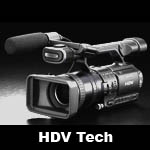The HDV Revolution
HDV is making a huge impact on Independent Film making, and is bringing affordable High Definition production to the masses. I like to say that HDV is doing for high definition, what dv did for standard def a few years ago. HDV is a new format which allows cameras to shoot high def on relatively inexpensive tapes, with relatively inexpensive cameras, and edit on relatively inexpensive computers. These cameras use the same tape transports as DV cameras and can in fact use DV tapes to record high definition, however the manufacturers recommend that you use HDV tapes for the best results. These tapes usually run about $15 for a 60 minute tape.
One of the nicest things about HDV is that it doesnít require a new computer interface, and uses the standard firewire connection already being used for DV. One thing to keep in mind though is that HDV is much more processor and memory demanding than dv, so just because your system has firewire and can edit dv, doesnít mean it will handle HDV. Typically you need at least a 3 Ghz PC with a gig or so of ram, and itís really preferable to have a dual core chip, and dedicated 7200 rpm hard drives. Also youíll probably need the latest version of your editing software., and there are even some plugins that make the job easier and more efficient. Weíll get into more details about editing with HDV and the specifics of some of the more popular applications such as Adobe Premiere Pro, Final Cut Pro, and Vegas in other episodes of the Short Way In.
One of the questions I get asked a lot is, whether or not HDV is true high definition. Which is a bit of a loaded question. High definition has several standards, and not all of these standards are equal. In short, the answer is, yes, HDV is high definition, however it is not the highest quality HD available. When you compare a $2000 HDV camera to a hundred thousand dollar Cine Alta camera there will be distinct differences. Image quality is dependant on several factors including lenses, compression algorithms, Image sensor size, and resolution as well as itís accuracy in sampling color information and dynamic range, or its ability to maintain detail in both dark areas and bright areas or the image. So generally speaking, a more expensive high definition camera will produce a higher quality image. Thatís not to say that these HDV cameras are not capable of producing quality images. They are, and Iím continually amazed by some of the imagery that people are pulling off with there cameras. Remember there are some compromises that come with scaling HD down to this price point, but overall this technology is exciting, and bringing HD to the masses.
I will go into greater detail about specific HDV cameras in the coming weeks, with some comparisons, and weíll also look at the new Panasonic P2 HVX camera, and see where this memory based HD camera fits into the grand scheme of things. Weíll show you the workflow on both Mac and PC, of both these technologies, and discuss how this technology can impact film productions in a positive way. Check out our website at theshortwayin.tv and click on the Articles Tab for more detailed information and examples as well as reviews on the latest gear and software for your independent film making adventures.
We want to hear from you!
If you are an independent film maker interested in featuring your short or independent film on The Short Way In, or are a company wanting us to showcase your product on the show, then let us know. Contact us at: Info@TheShortWayIn.tv
Version: 1.0 (Marchr 28, 2006)




